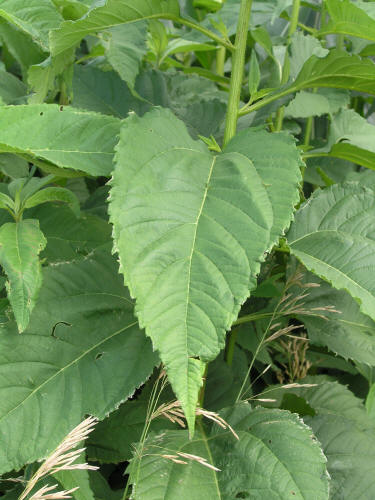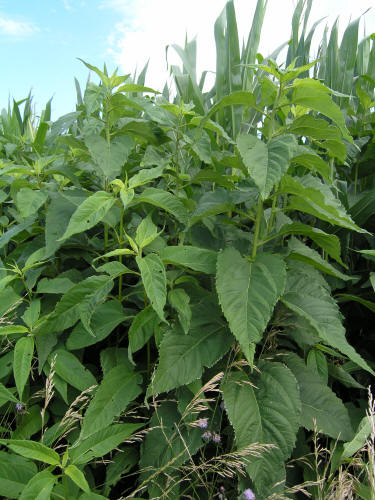Jerusalem Artichoke
Jerusalem Artichoke
Helianthus tuberosus L.
Asteraceae (Aster Family)
▲ colony along a road in Minnesota

▲ ▼ colony in a fallow field in Ohio

▲ ▼ flowers (head inflorescences)
▲ ▼ flowers (head inflorescences)
▲ ▼ flowers (head inflorescences)

▲ ▼ leaves and stems

▲ growing in corn in Indiana
▲ ▼ stems with rough hairs
Helianthus tuberosus L., Jerusalem Artichoke: (Bayer Code: HELTU; US Code HETU)
- U.S. native creeping perennial, rhizome-producing wildflower that produces thickened, branched tubers late each growing season; stems are 2-8 feet tall or more, usually with unbranched (except in upper portions as flowering commences), ridged, red-green to purplish ridged stems; stems have stiff white hairs and are rough textured
- Leaves are alternate (sometimes opposite, particularly toward base of plant), lanceolate, usually with toothed margins and a pointed tip; leaves have winged petioles and 3 main veins that initiate a short distance above where the petiole joins the leaf; upper leaf surface is rough-textured; lower surface is soft hairy
- Head inflorescences are 2.5-3.5 inches in diameter, produced at stem tips, with 10-20 yellow ray florets (“petals") that are puckered where they join the head, and 60 or more yellow disk florets
- Bracts below the head are in overlapping rows, lanceolate, with long, tapering, pointed tips; bracts edged with fine hairs
- Flowering from late summer through autumn
- Prefers full-sun, pastures, prairies, right-of-ways; is also cultivated for its edible root; has become naturalized in Europe
- The stiff white stem hairs, opposite leaves and alternate leaves on the same plant, and winged petiole with the 3 main veins starting above the leaf base help identify this species, along with its tubers; this sunflower species also hybridizes with other perennial and annual species, which can cause some real confusion in identification
Perennial sunflowers:
- Include Ashy Sunflower, Texas Blueweed, Maximilian Sunflower, Sawtooth Sunflower, Western Sunflower, Willowleaf Sunflower, Jerusalem Artichoke, and other species
- All are creeping perennial weeds that form rhizomes and/or creeping roots that allow them to spread to form colonies with maturity
- Most are palatable to livestock, except in fertile soils, where high nitrate accumulation may cause poisoning, but may be seen as weedy in reduced tillage crops
- Once established, these species can be hard to control, but most (not all) are not considered to be weedy
- Most produce relatively tall (4-8 feet tall or more), unbranched, leafy stems with linear, lanceolate to ovate/triangular, rough-textured leaves; upper stem portions are usually branched with the onset of flowering, so that each branch stem tip has a flower head
- Flowers for most perennial sunflowers quite similar (with some exceptions); they are in terminal clusters, flowering usually sometime from mid-summer to late autumn, with yellow ray flowers and yellow to brown disk flowers; total flower diameter is usually 2-4 inches
- Perennial sunflower “flowers" are usually smaller than annual sunflower “flowers," such as with Annual Sunflower (Helianthus annuus) or Prairie Sunflower (Helianthus petiolaris)
- Usually, it is more of the stem and leaf characteristics that are used to identify the different perennial sunflower species
- Click on links of above individual plant names to see more information on each one
- Most perennial sunflowers are native plants that usually do not cause harm in grazing or haying situations (maybe with the exception of Texas blueweed). Perennial sunflowers provide food and nectar for native insects (including bees and butterflies), birds and other animals, and generally should not be killed indiscriminately. Maintaining proper grazing levels can often reduce their unwanted increase in pastures and rangeland.
(Updated May 17, 2021)